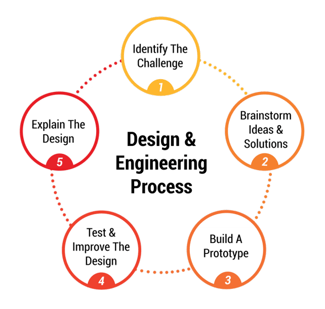.jpg?width=770&name=180919_KS-Shot-5_06-Final%20(16x9).jpg)
“The Engineering and Design Cycle? NGSS?? First Common Core, and now this new stuff. I can barely cover all the things I need to as it is, how am I supposed to fit in another thing? And Engineering?!? I can’t teach that, I wouldn’t even know where to begin!....”
If you’re like me, you might sometimes feel a sense of overwhelm as you’re asked to do more and more in the classroom, often with less resources. But I have great news: NGSS (short for Next Generation Science Standards) may be a new abbreviation to learn, but the Engineering and Design Cycle (also known as the Engineering and Design Process) is actually something most of you are already doing in your classroom. Rather than seeing it as a list of things you have to accomplish, NGSS can be reframed as a unique way to build classroom culture that embraces STEM education. It’s a way to teach students to work together, challenge themselves, take risks, and learn from their mistakes.
STEM education is already happening in your classroom
Take a look at a few real-world examples of the engineering that kids are already involved in, and notice whats these things all have in common.
 Do you ever notice students discovering that everyday objects can be used in new and different ways? Maybe you’ve passed out paper towel rolls for a craft, only to see them repurposed as telescopes or megaphones before you’ve even described the activity at hand.
Do you ever notice students discovering that everyday objects can be used in new and different ways? Maybe you’ve passed out paper towel rolls for a craft, only to see them repurposed as telescopes or megaphones before you’ve even described the activity at hand.
Or, have you watched Kinder kids with wood blocks, trying so hard to get them stacked just right, so they can build a HUGE tower. Focused on getting them positioned just right, taking the time to add one piece at a time, little by little, working so hard, until finally, SUCCESS! And then what do they do? Knock it down!
All of this commotion and chaos in the classroom might drive us a bit batty, but the point is that THIS is what the Engineering and Design Cycle is all about. The Engineering and Design process takes the natural love of “tinkering” to the next level. The formula is simple and uses students’ natural curiosity to drive instruction by following a cycle of learning and discovery.
Parts of it are new, most often labeled as STEM education, but a lot of the Engineering and Design Cycle builds on what you’re already doing in your classroom with just a different label. In fact, you might even start to see parallels with other subject areas, like the writing process (prewriting, drafting, revising and editing, rewriting, publishing), within the cycle!
STEM activities for preschool and elementary school
To better understand the engineering and design cycle, let's look at a simple example of STEM activities for preschool or elementary school. I do this as a team-building activity at the beginning of the year, and have done versions of it with groups as young as TK all the way through 8th grade.
ACTIVITY: Students work in groups to build a structure out of aluminum foil. The only supplies needed are a roll of foil and a flat surface. (I suggest building on the floor for safety’s sake.)
Step One: Identify the challenge
You can start by asking students a question. Students are already asking questions in math, reading, and many other subjects; this question just focuses on solving a problem. “How can we build the TALLEST FREESTANDING tower out of aluminum foil?” Then have students articulate what they understand to be the challenge (answer: build the tallest freestanding tower).
Step Two: Brainstorm ideas and solutions
Invite students to share their ideas. Write down as many as you can (or incorporate writing skills by having them first write down their ideas and then share with the group). Remember, all ideas are good at this point. This gives students great practice for brainstorming for future activities like writing, and gives all students a chance to contribute because there is no "wrong" answer. As a group, pick the most reasonable idea/design, and ask all students draw a picture, diagram, or write instructions for how they will implement the chosen design.
Step Three: Build a prototype
Now ask students to go from the idea phase to the doing phase by actually building their tower based on their original ideas. During this phase, you will get a chance to see leadership qualities in a different light, and from different students. This is a great access point for struggling readers, English Learners, and students with disabilities as they can experience success alongside their classmates. In fact, many times they really shine during these activities.
Step Four: Test and Improve
This is where the bulk of the learning takes place. Students will inevitably experience some kind of failure at this point. Their tower won’t stand, or won’t be as tall as they wanted. The tinfoil might crumple or tear in a way they didn’t expect. Then, one of many things can happen. Some students may experience frustration, but then channel that frustration into trying new ideas. Some have moved away from their group and are deep in thought about what to do next. Some are just thinking of quitting. Encourage students to regroup and analyze why their design isn’t working the way they hoped, and then look for ways to improve. That could mean keeping what worked and improving the things that didn’t, or just starting from scratch.
This phase is also important for developing resilience by continuing to work on something, even when they experience failure. All of our students need to learn to be resilient if they are going to succeed. They need resilience if they are going to take risks and challenge themselves as learners.
Step Five: Explain the design
Once students have more or less successfully completed the challenge, ask them to explain to the class how they developed their design, including the steps they followed in the Design and Engineering Cycle. This helps students see that there are multiple solutions to a problem, and they also learn from their peers.
This foil tower activity, and other STEM/Engineering activities, can be great hands-on examples for students to see first-hand how important it is to try something more than once. Through this activity, they understand that almost nothing is perfect the first time around, and that making improvements is an ongoing process.
And don't forget Step Six: CELEBRATE!
Engineering for kids is central to integrated learning
While at times it can seem overwhelming, STEM activities are just another way to look at the learning process. They use the innate curiosity students have and are a great way for your students to connect. All they need to do to be successful is to try, and be resilient if something fails. Barriers like language and reading levels are easily overcome. Students are DOING. All we need to do as educators is to guide them, and encourage them to do their best, take risks, and have fun. And who knows...you might have some fun too!
.png?width=1270&height=453&name=Copy%20of%20Kid%20Spark%20Logo%20(Horizontal%20-%20Full%20Color).png)
